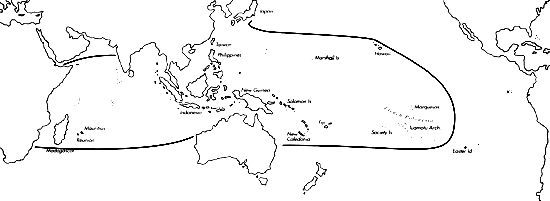Range: S. and E. Africa to Hawaii and French Polynesia; absent from the Red Sea.
Description: Moderately small to medium-sized, light to moderately light. Last whorl cylindrical to narrowly cylindrical; outline almost straight; left side slightly concave at basal fourth to third. Aperture wider at base than near shoulder. Shoulder angulate. Spire usually of moderate height, outline straight or slightly concave. Larval shell of 3.75-4.0 whorls, maximum diameter about 1 mm. First 2-4 postnuclear whorls tuberculate. Teleoconch sutural ramps flat to slightly concave, with 1 increasing to 4-6 major spiral grooves, sometimes to 8 finer grooves; sculpture usually weak on late ramps. Last whorl with a few weak spiral ribs at base.
| Shell Morphometry | ||
|---|---|---|
| L | 25-44 mm | |
| RW | 0.02-0.06 g/mm | |
| RD | 0.46-0.52 | |
| PMD | 0.58-0.74 | |
| RSH | 0.11-0.16 | |
Last whorl greyish blue to violet. Variably prominent spiral rows of alternating brown and grey dots and dashes from base to shoulder. Brown flames, clouds and blotches usually concentrated in spiral bands below shoulder, just above centre and within basal third. Larval whorls red to orange. Early postnuclear sutural ramps grey, often dotted with dark brown at both margins in first whorl and with brown radial lines and streaks in following whorls. Later sutural ramps bluish grey with confluent brown radial blotches, often completely overlaid with brown. Aperture translucent or with thin white enamel.
Periostracum yellow, very thin, translucent, smooth (Kohn, 1959a; Cernohorsky, 1964).
Dorsum of foot white to pink, heavily mottled with tan to reddish brown; pattern concists of discrete spots and longitudinal bars medially, white elements fuse marginally. Sole of foot pink, mottled with light brown. Rostrum pink, with closely spaced brown axial streaks, or solid brown. Tentacles white, may be mottled with brown. Siphon white to pink, with closely spaced reddish brown transverse stripes on underlaying brown blotches, or solid brown; tip white edged with pink or yellow (Pl. 76, Fig. 51; Pl. 81, Fourth row, right) (Kohn & Weaver, 1962; Chaberman, pers. comm., 1981; Pearson unpubl. observ.).
Radular teeth with 2 small adapical barbs in line and an opposite third long barb with a variably pointed posterior tip; serration and basal spur absent (James, 1980; Kohn, unpubl. observ.).
Habitat and Habits: Intertidal to more than 40 m, more common subtidally; usually reported from coral reefs. On various reef substrata (in caves among coral heads, on coral rubble among sea-weed, and on patches of sand) as well as on intertidal rocky flats exposed to wave action (Kohn, 1959a; Kohn & Weaver, 1962; Richards, pers. comm., 1989; Grosch, pers. comm., 1989). C. obscurus feeds on fishes; known human injuries resemble beestings (Kohn, 1963). In Hawaii, egg diameter of 147 ┬Ám predicts a pelagic period of about 28 days (Perron & Kohn, 1985).
Discussion: C. tulipa is similar in pattern and also lacks shoulder tubercles in the late postnuclear whorls. However, it attains larger size (to 95 mm), has a generally broader and often ovate last whorl (RD 0.50-0.57), a subangulate shoulder, and more tuberculate early postnuclear whorls (4-7). C. obscurus lacks a brown sutural line on the larval shell and prominent marginal dots on the early postnuclear sutural ramps (except first whorl), while C. tulipa does not have the late sutural ramps overlaid with brown. C. geographus, C. eldredi and C. fragilissimus can be distinguished from C. obscurus by their white ground colour and tuberculte later postnuclear whorls. C. halitropus refers to a pattern variant of C. obscurus without dotted and dashed spiral lines on the last whorl.

C. obscurus range map
This section contains verbatim reproductions of the accounts of 316 species of Conus from the Indo-Pacific region, from Manual of the Living Conidae, by R÷ckel, Korn and Kohn (1995). They are reproduced with the kind permission of the present publisher, Conchbooks.
All plates and figures referred to in the text are also in R÷ckel, Korn & Kohn, 1995. Manual of the Living Conidae Vol. 1: Indo-Pacific Region.
The range maps have been modified so that each species account has it own map, rather than one map that showed the ranges of several species in the original work. This was necessary because each species account is on a separate page on the website and not confined to the order of accounts in the book.